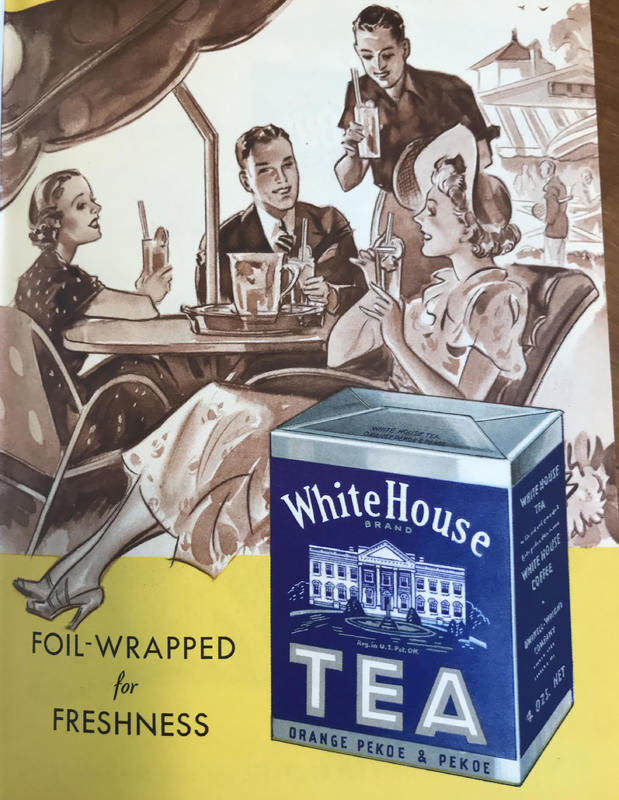1930s: The Great Depression
When the stock market crashed on October 24, 1929, the United States and the rest of the world fell into the Great Depression (Reeves 101). By 1932, the national income dropped from $82 billion dollars to $40 billion dollars, and twenty-five percent of the workforce lacked jobs, with industrial cities facing the brute of unemployment (Reeves 102). When Franklin D. Roosevelt became president in 1932, he set out a New Deal plan in an attempt to stop the damages from the Depression (Reeves 106).
Much of everyday family life was halted in the thirties, as marriages were delayed and birth rates decreased. Women’s fashion became more traditionally feminine, unlike the previous flapper movement, with skirts falling below the knee and hair accessorized with hats and bows (Reeves 115). Since consumerism went down, there was not much buying and selling of products towards the beginning of the Depression. Towards the end of the Depression, around the time when FDR’s New Deal began to end in 1937, there was more push for advertising and consumerism (Reeves 114). The tea advertising in this exhibit section is from the late 1930s as opposed to the beginning when the Depression started.
These two advertisements were featured in a pamphlet promoting two different types of White House Tea, not in flavor, but in preparation and advertising. The advertisement with just women is promoting hot tea, while the advertisement with the group of mixed genders is drinking a form of tea that has not been shown in this exhibit yet: iced tea. Ice tea is not a new invention as there have been records of iced tea recipes in American cookbooks since the early 1800s (Saberi 94). During the 1900s, the popularity of iced tea grew significantly (Saberi 95). This is the first advertisement in our exhibit where both men and women are represented drinking tea. However, these two advertisements side by side gives off the appearance that men only drink iced tea, while the hot tea is still feminized to be a women’s only beverage. It was difficult to promote tea to all genders in the United States because of the stereotype that it was not a drink fit for a man unless he was a “sissy”. Men controlled the advertising market; if they promoted tea, a feminized beverage, to men, it would threaten their masculinity (Chatterjee). Iced tea was not the “typical” hot tea that grew a reputation of being feminized; it was an American invention that was a distinct version of tea and allowed men to feel more comfortable about drinking it. Iced tea in advertisements demonstrates that it is a beverage that women will provide to men to make them happier, which coincides with one of Parkin’s food advertising themes (Parkin 9).
The White House Tea Advertisement with only women is still a representation of the traditional domesticity and feminized characteristics. The women are dressed in typical 1930s clothes, with dresses on, ruffles on the collars, and bows in their hair (Reeves 115). They are having their beverage at a “tea table,” a symbol of domesticity and feminization. They are separated from the outside and are “aristocrats of the interior” (Chatterjee). This symbol of the tea table has been presented in many images in history to depict tea as a feminized beverage and a way for women to have a leisurely time in their domestic space as opposed to a man’s working one (Chatterjee). The way the tea table is presented here is no different. The women are enjoying their hot tea inside with each other, as opposed to being exposed to the outside working world. This advertisement demonstrates their traditional tea drinking ways: being inside surrounded by other women, leisurely taking a break before having to do more domestic housework later on. There is a contrast between this advertisement and for the advertisement with iced tea, which is outside in the open and includes both men and women drinking it.
Lipton’s Tea advertising in 1938 decides to tell the story of the tea leaf process to the American consumer to help promote purchases of the product. The tea process starts with the depiction of a worker from Ceylon, smiling and picking tea leaves for the white consumers. A sense of exoticism is presented in the tea, since its leaves are picked and processed all the way in Sri Lanka. Ramamurthy talks about the smiling worker as being a mask and silence to the truth about their real-life depictions. The whole labor process ends up being overshadowed by the consumerism and domesticity that this advertisement shows, especially since the rest of the labor process in step two is done by a white individual (Ramamurthy 373). By not showing the full steps of the labor process of tea, homemaker consumers do not have to worry about the needs of the worker, they just have to worry about their family’s needs instead.
Moving forward with the tea process, the third step talks about how Lipton tea should be shared by everyone. It begins by stating, “A tea with such a record deserves a trial by you” and displays a drawing of a woman serving tea to her family waving in the back. One of Parkin’s food advertising themes states that women should show their love to their families through food, which is signified through the women’s roles in the advertisement (Parkin 8). The woman is serving a tray of iced tea to a group of waving people outside, demonstrating her role as a homemaker making tea for everyone. The fourth and final step also contains a signifier of the Parkin theme, as the final statement says, “Get a package of Lipton’s Tea from your grocer today. Serve it to your grateful family tonight.” This message implies that the homemaker is buying this tea with the intention of serving it to her family, which plays into the Parkin theme “Food is Love.” There is a sense of pressure and urgency that is demonstrated in this ad, implying that the homemaker must buy this tea and serve it immediately to be shown the gratitude by her family.



